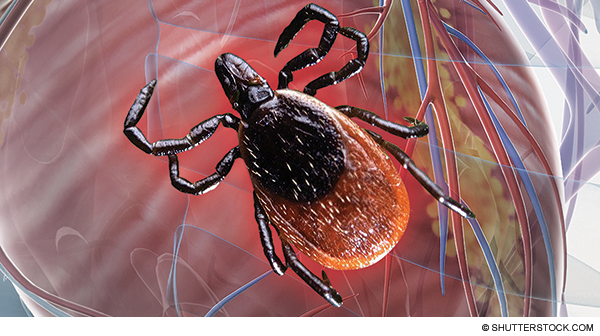
Acute clinical illness is usually characterized by fever and constitutional symptoms combined with a distinctive rash, erythema migrans (EM), which develops at the site of the tick bite in approximately 70 to 80 percent of patients.4 However, without early appropriate antibiotic therapy, infection can disseminate to other tissues, causing peripheral and central neuropathy, arthritis, and carditis.
Explore This Issue
ACEP Now: Vol 33 – No 08 – August 2014Lyme carditis, which most commonly manifests as atrioventricular (AV) conduction block, results from the host inflammatory response directed at spirochetes in cardiac tissue. Among Lyme disease case-patients reported to the CDC, approximately 1 percent had documented Lyme carditis (defined as associated second- or third-degree AV block). Although death is extremely rare, second- and third-degree AV block can progress to fatal arrhythmias if not managed and treated appropriately, underscoring the need for accurate and timely diagnosis.
Certain demographic groups appear to be at higher risk of developing Lyme carditis. Males and young adults are disproportionately affected by Lyme carditis [CDC; unpublished data]. Common symptoms of Lyme carditis include lightheadedness, palpitations, shortness of breath, chest pain, and syncope and can occur several days to six months after onset of disease (median of 21 days).5 Patients with Lyme carditis typically present during the summer months. Notably, a history of an EM lesion is reported less frequently in patients with Lyme carditis for unknown reasons [CDC; unpublished data]. However, absence of an EM lesion should not rule out Lyme carditis in an otherwise appropriate clinical scenario, although recommended serologic evidence of Lyme disease should be obtained to ensure correct diagnosis.
Emergency health care providers should consider Lyme disease in patients with cardiac symptoms who are residents of, or have recently traveled to, regions with high incidence of Lyme disease. Additionally, emergency health care providers should investigate heart block in patients with Lyme disease if clinically indicated. Importantly, providers are advised to consider obtaining an ECG in men and young adults from, or with recent travel to, high-incidence Lyme disease areas who present with symptoms of Lyme carditis, such as chest pain, palpitations, lightheadedness, shortness of breath, and syncope, particularly during summer and fall months.
Emergency physicians are in a unique position to recognize and diagnose Lyme disease before it progresses.
Recommended treatment algorithms for Lyme carditis have been established by the Infectious Diseases Society of America, and readers are directed there for additional therapeutic information (see Table 1).6 Hospitalization and continuous cardiac monitoring should be considered for symptomatic patients, any patients with second- or third-degree heart block, or those with first-degree block with a prolonged PR interval (>30 milliseconds).6 Confirmatory laboratory evidence of infection should not delay supportive care in appropriate clinical scenarios. Recommended parenteral antibiotics should be administered during hospitalization.6 For patients with severe heart block, a supportive temporary pacemaker may be required. The prognosis is generally excellent with appropriate antibiotic therapy. Most patients will experience resolution of symptoms and ECG abnormalities within one to six weeks, depending on the degree of initial conduction disturbance.7,8 An oral antibiotic regimen can be used to complete a course of therapy upon hospital discharge.6
Pages: 1 2 3 4 | Single Page





No Responses to “Risk of Sudden Cardiac Arrest from Lyme Carditis Underscores Need for Timely Diagnosis, Treatment”